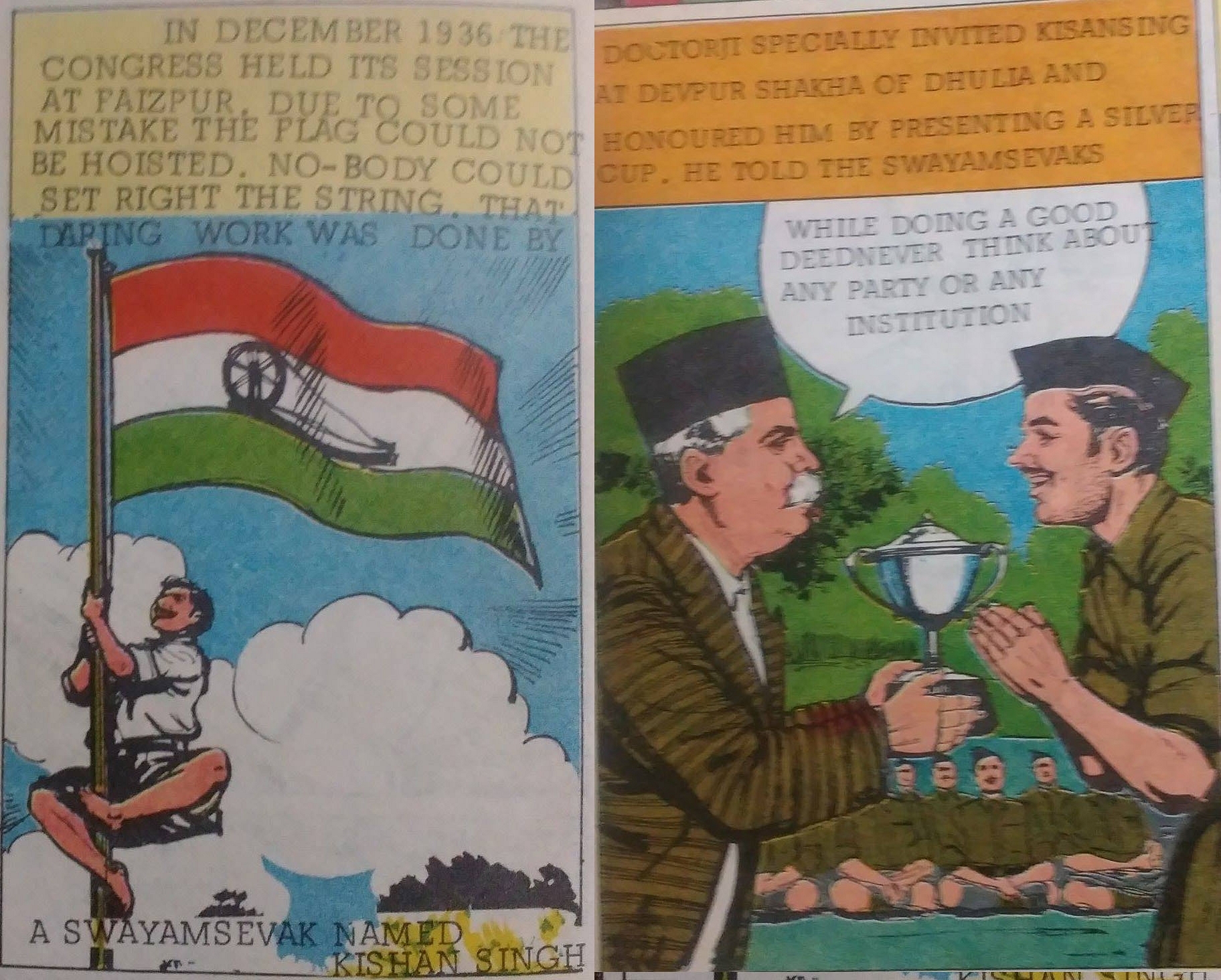Politics
Guha Is Wrong. RSS Never Had Any Shade of Doubt in Hoisting The Tricolour
- - The RSS has shown neither disrespect nor nonacceptance towards the national flag.
- - Savarkar, too, hoisted the original tricolour flag designed by Madam Cama as early as 1937.
- - One can only wish our ‘eminent historians’ would rather do some non-partisan research than reinforce the stereotypes for vested political interests.

Sangh Comics books panels inculcating respect for the tri-colour: ‘Dr.Hedgewar’ published in 1982-83
Suddenly the national Tricolour and the RSS loyalty to it have been brought back into the center stage of controversy. Ramachandra Guha has been persistently making a claim. As early as 2004 he claimed that ‘during the thirties and forties, few, if any, RSS workers were seen saluting the national flag. Their allegiances were sectarian rather than national—indeed, they chose to elevate their own Bhagwa Dhwaj above the tiranga jhanda.’ And in 2016 he tweets again that the ‘RSS’s acknowledgement of our national flag was very belated and totally opportunistic. They would far prefer the bhagwa dhwaj.’
A quick look at facts through history shows otherwise.
While the RSS does consider the saffron flag as the national Guru and as the flag of the national resistance to invaders from time immemorial, it has shown neither disrespect nor nonacceptance towards the national Tricolour. In fact, saffron coloured flag as the national flag was recommended by some of the greatest stalwarts of Indian secularism.
On April 2, 1931, the Karachi Indian National Congress created a Committee of seven persons to recommend a flag for the Congress and to examine the opposition people had for the flag it had then. Popularly known as ‘Flag Committee’, it contained among others, Sardar Patel, Abdul Kalam Azad and Jawaharlal Nehru. After getting the opinions of the Provincial Committees and members of AICC, the flag committee recommended the saffron flag with the emblem of the blue spinning wheel at the top corner. This flag was submitted to the Party. This was in August 1931. Of course, the Congress ‘High Command’ rejected it.
Dr BR Ambedkar gave assurance to Hindu Maha Sabha leaders headed by S K Bole that if they initiate a popular movement to have the saffron flag as the national flag, he will support it. And in case someone wanted to brand the saffron flag as ‘Brahminical’, it was important to know that S K Bole (called ‘Baba Saheb’ by Dr Ambedkar himself) was not only the HMS leader but also an important backward classes leader - a prominent leader in the non-Brahmin movement of Maharashtra.
Interestingly, when radical elements of HMS were hesitant to accept the national Tricolour, Veer Savarkar, the tallest of HMS leaders, made it a point to respect the national Tricolour. After all the original tri-colour was designed by none other than Madam Cama - the revolutionary colleague of Savarkar. Even as he was with the HMS, Savarkar paid his respects to the national Tricolour by hoisting it in 1937 at Poona. Again when India got Independence he hoisted the national and the HMS flag.
The RSS founder Dr KB Hedgewar also never allowed the rejection of the saffron flag by the Congress to cloud the vision of RSS cadre. In December 1936, the INC session was held at Faizpur. The Tri-colour flag got struck due to some mistake. It was an RSS cadre, Kishan Singh Rajput, who climbed the pole, set right the string and made the flag fly high.
Dr Hedgewar conducted a special event and honoured the youth with the silver cup for doing the ‘good deed without thinking about any party or organization.’ This particular event has ever been repeated in RSS literature. For example, one finds this episode described in Organiser (1978), Malkani’s ‘The RSS story’ (1980), and Manthan of Deendayal Research Institute (1989). It was also presented graphically in a 1982-published comics book form the biography of Dr Hedgewar, an in-house Sangh publication.
So the assertion by the likes of Guha that the ‘RSS acknowledgement of our national flag was very belated and totally opportunistic’ is nothing but a repeated falsehood. One can only wish our ‘eminent historians’ would rather do some non-partisan research than reinforce the stereotypes for vested political interests.
Support Swarajya's 50 Ground Reports Project & Sponsor A Story
Every general election Swarajya does a 50 ground reports project.
Aimed only at serious readers and those who appreciate the nuances of political undercurrents, the project provides a sense of India's electoral landscape. As you know, these reports are produced after considerable investment of travel, time and effort on the ground.
This time too we've kicked off the project in style and have covered over 30 constituencies already. If you're someone who appreciates such work and have enjoyed our coverage please consider sponsoring a ground report for just Rs 2999 to Rs 19,999 - it goes a long way in helping us produce more quality reportage.
You can also back this project by becoming a subscriber for as little as Rs 999 - so do click on this links and choose a plan that suits you and back us.
Click below to contribute.
Latest